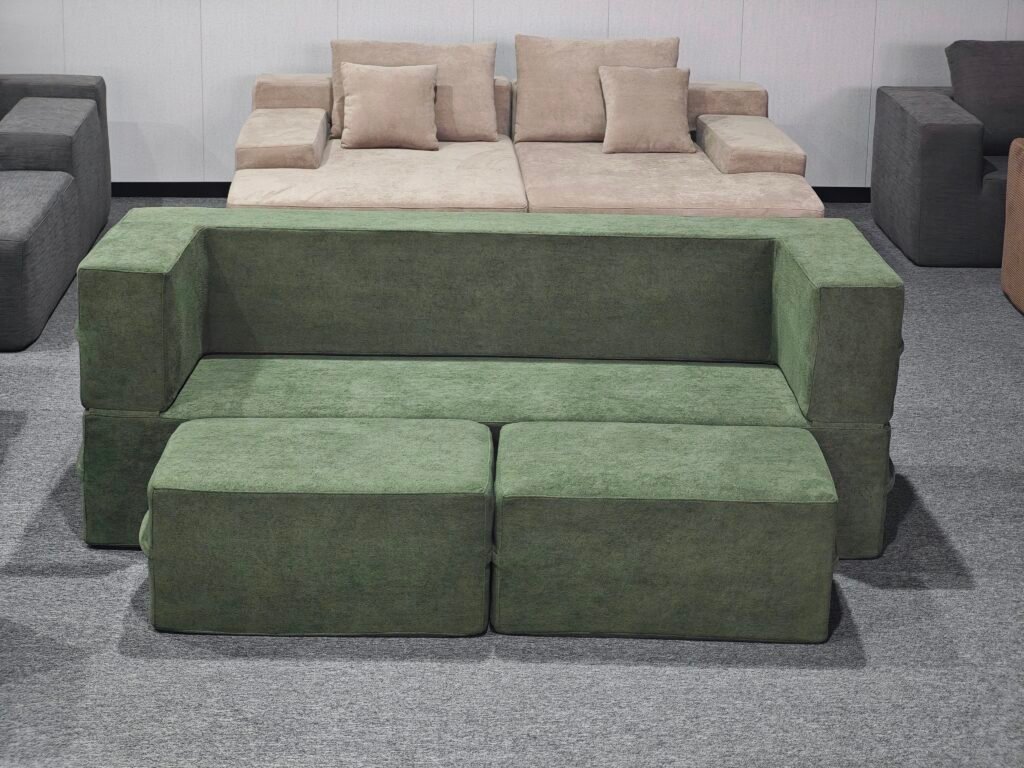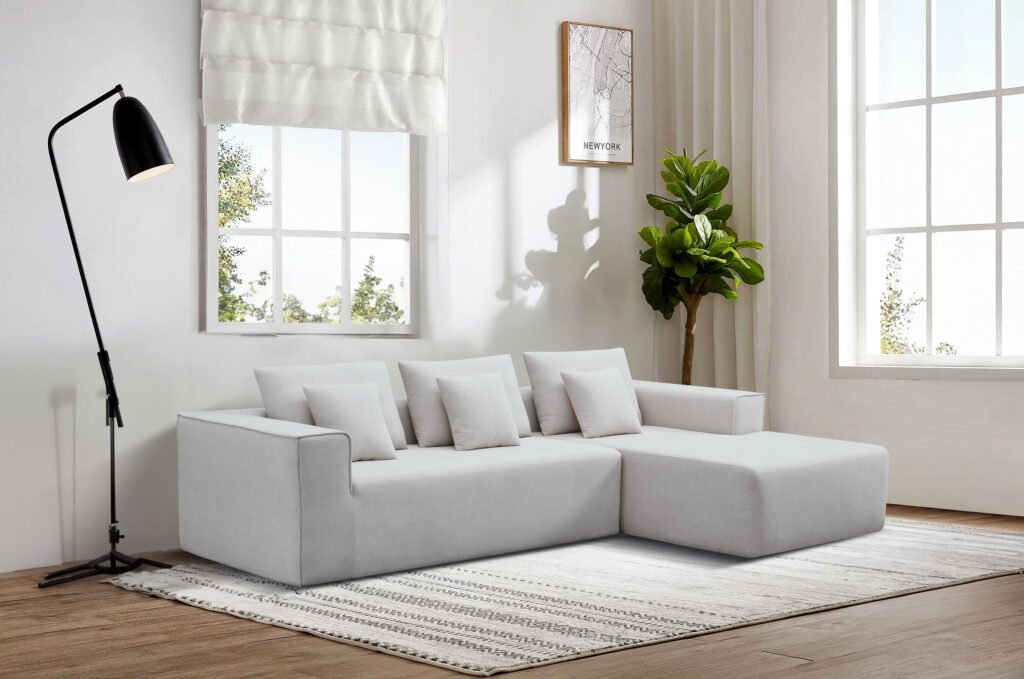Traditional sofas are not just big—they are unwieldy. Even relatively modest three-seater couches take up a massive amount of space, forcing businesses to ship mostly air. The move to compressed sofas, pioneered by leading companies like Modular-Sofas.com, completely turns this model on its head. By using vacuum compression, modular structures, and smarter packaging, it is possible to reduce sofa volume by as much as 85%–90%.
This innovation cuts transportation costs, enables higher inventory turnover, allows for rapid scaling, and reduces the environmental footprint of each shipment. The compressed sofa industry leverages technology at every step—design, manufacturing, packing, shipping, logistics, customs, and final-mile delivery—to squeeze out unnecessary expenses and offer world-class products at highly competitive prices.


Key Cost Drivers in Overseas Sofa Shipping
Let’s delve into the main cost components impacting overseas sofa shipments:
- Freight cost per cubic meter or kilogram
- Packing and labor expenses
- Warehouse rental and handling
- Custom duties, import taxes, VAT, and regulatory charges
- Damage and insurance claims
- Logistics for last-mile delivery (from port to buyer)
- Environmental charges or green incentives (increasingly relevant)
By optimizing each of these drivers, a compressed sofa factory unlocks consistent, compounding savings.
Traditional vs. Compressed Sofa Shipping: A Side-by-Side Comparison
| Shipping Method | Estimated Sofas per 40ft Container | Volume/Floor Space Needed | Labor/Handling Complexity | Cost per Sofa (Average) |
|---|---|---|---|---|
| Traditional (Fully Assembled) | 30–50 | Very high | Difficult | Highest |
| Modular, Compressed | 180–300 | Up to 90% less | Easier | Up to 80% lower |
Optimizing Product Design for Maximum Compression
The foundation of shipping efficiency is product engineering. To maximize compression, a sofa must:
- Use high-resilience, quick-rebound foams that survive and recover from prolonged vacuum compression.
- Feature modular, foldable frame construction—using lightweight metals or engineered woods with hinges, locking pins, or foldable joints.
- Employ durable, slightly elastic upholstery fabric that stretches under compression, then recovers to original form.
- Be designed in easily separable modules (arms, seat, back) that nest or stack efficiently within the carton.
Modular-Sofas.com, as an example, invests extensively in product innovation—ensuring every new line is not only attractive to consumers but designed for compact, damage-free compression and effortless assembly post-delivery. This design philosophy directly impacts shipping costs and market access.
Investment in Vacuum Compression Technology
While some compression benefits can be achieved with simple folding, true cost-cutting relies on industrial vacuum compression machines. These systems:
- Remove the vast majority of air from the sofa and packaging, shrinking volume to its physical minimum
- Stabilize the compressed sofa in wrap-tight plastic or eco-friendly barrier bags, preventing expansion until the customer opens it
- Allow for rolling, folding, or stacking—so the resulting packages fit into shipping containers like perfectly calculated puzzle pieces
This investment is quickly recouped through higher container utilization, fewer shipping cycles, and reduced damage rates.
Packaging Optimization: The Silent Cost Killer
Packaging may seem minor, but it is a critical lever for cost extraction. The goal is not just to protect the sofa but to use the smallest viable carton, custom-sized for each model and shipping method:
- Custom-fit cartons fill the available container space with close tolerances, reducing wasted air.
- Multi-layer approaches (an inner protective wrap, shock-absorbent mid-layer, and a sturdy outer box) balance durability and minimal weight.
- Where possible, eco-friendly and recyclable packaging reduces both costs and environmental regulatory charges.
- Smart labeling allows rapid aggregation and customs processing, further accelerating and de-risking shipping.
Strategic Container Planning and Maximization
The “per container” price of international sea freight is a major overhead. Key strategies include:
- Using digital layout modeling (CAD/CAM, 3D simulation) to maximize how compressed sofas are loaded.
- Consolidating shipments by batch, ensuring each container is shipped fully loaded (“full container load”—FCL—a key criterion for the lowest cost per sofa).
- When feasible, using “double stacking” or vertical stacking of cartons for even greater cubic efficiency.
Regular measurement and auditing of “container fill rate” (the percentage of actual product volume relative to container maximum) is vital. Some leading compressed sofa factories report frequently achieving 80%–95% container fill—compared to only 30%–60% for traditional bulk furniture.
Selecting the Most Cost-Effective Shipping Routes and Methods
Not all routes are equal. When exporting compressed sofas, a factory should:
- Compare sea freight, rail freight, and in rare cases, air freight when time sensitivity or high value merit the cost.
- Use direct routes when reliability trumps cost, but embrace “transshipment” (via hub ports) to save money for less time-sensitive deliveries.
- Research and negotiate with multiple carriers; digital logistics brokers and reverse auctions can yield surprise savings.
- Plan shipments around low-season freight periods (avoiding the “Chinese New Year rush” or seasonal spikes) to save further.
Experienced logistics officers at Modular-Sofas.com monitor global shipping trends, locking in favorable rates when possible and adjusting routes to exploit currency swings, fuel price troughs, or regional oversupply.
Leveraging Bulk and Long-Term Carrier Contracts
Shipping rates reward scale and predictability. Compressed sofa factories should:
- Negotiate annual or multi-shipment contracts with preferred carriers, often in exchange for fixed rates or early booking discounts.
- Bundle cargo with other shippers (if working with less-than-container loads, "LCL") to gain additional economies of scale.
- Build relationships with major 3PLs (third-party logistics providers) with expertise in furniture or modular goods.
The purchasing power of a steady exporter can sometimes reduce ocean freight rates to less than half the published “spot” rate.


Reducing Customs, Duties, and Bureaucratic Roadblocks
Even the most efficient shipment loses value if it languishes at customs or incurs unexpected tariffs. To cut these costs:
- Prepare thorough, accurate documentation (commercial invoices, packing slips, HS codes) and submit pre-clearance digital files in advance.
- Utilize customs brokers or import/export agents in destination markets, especially when regulations are opaque or changing.
- Select the optimal HS (Harmonized System) code category, as compressed or flat-pack furniture is sometimes eligible for lower tariffs or green channels.
- Investigate “free trade zones” or bonded warehousing when clearing goods in countries with complex import regimes.
Efficient customs processing saves money not only through direct tariff reduction but by minimizing port storage time and preventing penalty fees.
Optimizing Warehouse, Handling, and Last-Mile Delivery
After customs clearance, sofas need to be warehoused (sometimes briefly) and delivered to wholesalers, retailers, or consumers. Key savings strategies include:
- Using multi-story, high-density warehouses that are ideally located close to major ports, reducing storage rent and local trucking charges.
- Automated warehouse management systems (barcode or RFID based), which cut error rates and handling costs.
- Stackable, uniform cartons simplify storage and retrieval—one more advantage of tightly compressed, modular packaging.
For last-mile delivery, compressed sofas excel. They fit in smaller trucks and vans, can enter buildings with restricted or narrow access, and may be delivered without special lifting equipment, thanks to reduced parcel size and weight. This is a substantial source of cost savings in dense urban centers where traditional sofa delivery is expensive and complex.
Sustainability and Environmental Considerations
Increasingly, compressing and shipping sofas efficiently is not just about cost—it is about sustainability, brand image, and compliance:
- Efficient shipping means fewer total trips, hence less fuel burned and a lower carbon footprint per product.
- Minimizing packaging waste with smart designs can reduce environmental taxes and appeal to green-conscious consumers.
- Several countries or ports now offer “green lane” incentives (discounted fees, faster processing) for high-density, eco-labeled shipments.
Modular-Sofas.com, for example, uses recycled or reused material where possible and partners with logistics providers who track, report, and optimize environmental performance.
Continuous Monitoring with Key Performance Indicators (KPIs)
Factories should routinely measure:
- Cost per shipped sofa: from door to door, not just to port
- Container utilization rates: actual fill % per container, per route, and per month
- Damage/loss rates: ensure that cost savings in compression or packing are not offset by higher rates of goods damage
- Customs clearance times and fees: to identify bottlenecks and fix process flaws
- Customer delivery satisfaction: including free shipping, returns, or claims handled smoothly
Only with relentless monitoring and incremental improvement do cumulative cost advantages accrue and remain reliable as the market evolves.
Case Study: How Modular-Sofas.com Executes Cost-Efficient Overseas Shipping
As a specialized compressed sofa factory, Modular-Sofas.com demonstrates the results of these best practices:
- Every sofa model is designed from inception for compressibility, modular assembly, and carton uniformity.
- Industrial vacuum compression systems enable rapid, reliable sealing that does not compromise sofa integrity.
- Packaging is tested under simulated shipping stress, optimizing balance between size, durability, and eco-impact.
- Digital supply chain management links production, logistics brokers, carriers, and customs agents in real time, maximizing flexibility and minimizing delays.
- Warehouses are managed for just-in-time shipments, keeping inventory low but ensuring fast turnover.
- Customers are provided with detailed, easy assembly instructions, minimizing return rates and ensuring positive unboxing experiences.
Advanced Strategies and Industry Trends for Future Savings
Beyond today’s best practices, several future-leaning strategies hold promise for cost reduction:
- AI and predictive analytics for logistics: forecasting delays or pricing spikes based on global data.
- Blockchain-enabled smart contracts to streamline documentation, payment, and compliance.
- Ultra-lightweight structural materials (e.g., advanced polymers or carbon fiber) to further reduce per-unit shipping weight.
- Regional micro-factories or assembly centers: shipping components in compressed bulk, then assembling or customizing close to final markets for ultra-efficient last-mile delivery.
Future scenarios envision a world in which compressed, modular furniture can be manufactured near-shore or on-demand, creating even deeper supply chain and shipping efficiencies.


Summary Table: Comprehensive Cost-Saving Techniques for Shipping Compressed Sofas Overseas
| Stage/Area | Technique or Best Practice | Typical Cost Impact | Additional Benefits |
|---|---|---|---|
| Sofa Design | Modular, highly compressible frames & foams | Major | Product flexibility, fewer returns |
| Vacuum Compression | Industrial vacuum sealing and rolling/folding | Major | More sofas/unit, less damage |
| Packaging | Custom-fit, minimal, stackable eco-cartons | Moderate to Major | Reduced waste, better brand image |
| Container Loading | Digital simulation, maximum fill, double stacking | Major | Lower per-unit sea freight |
| Carrier Negotiation | Long-term or volume-based shipping contracts | Moderate | Predictable costs, priority space |
| Documentation & Customs | Digital docs, expert brokers, HS code optimization | Moderate | Fewer delays, reduced duties |
| Warehouse/Last-Mile | Automated storage, urban hubs, efficient small-package delivery | Moderate | Customer satisfaction, lower handling |
| Sustainability/Regulatory | Green packaging, logistics partners, carbon offsets | Growing | Positive reputation, compliance |
Conclusion
Successfully cutting costs when shipping compressed sofas overseas is an ongoing, holistic process. It begins with engineering sofas for compressibility and robust self-assembly, extends through every layer of packaging and logistics, spans detailed negotiation and process monitoring, and even influences materials sourcing and digital supply chain management. Few other industries illustrate as well how design and logistics innovation can simultaneously improve efficiency, affordability, customer experience, and sustainability.
For compressed sofa factories such as Modular-Sofas.com, this approach enables global expansion, lean manufacturing, and market leadership—while giving modern consumers the flexible, attractive, and affordable furniture they demand. These methods, integrated at every stage of the value chain, define the future of global furniture trade.
If your business seeks to further optimize, consider deep-diving into regional regulatory nuances, working actively with experienced 3PL/4PL providers, and leveraging data analytics to find fresh cost-saving opportunities as markets and shipping technologies evolve. With vigilance and innovation, the compressed sofa revolution is only just beginning.